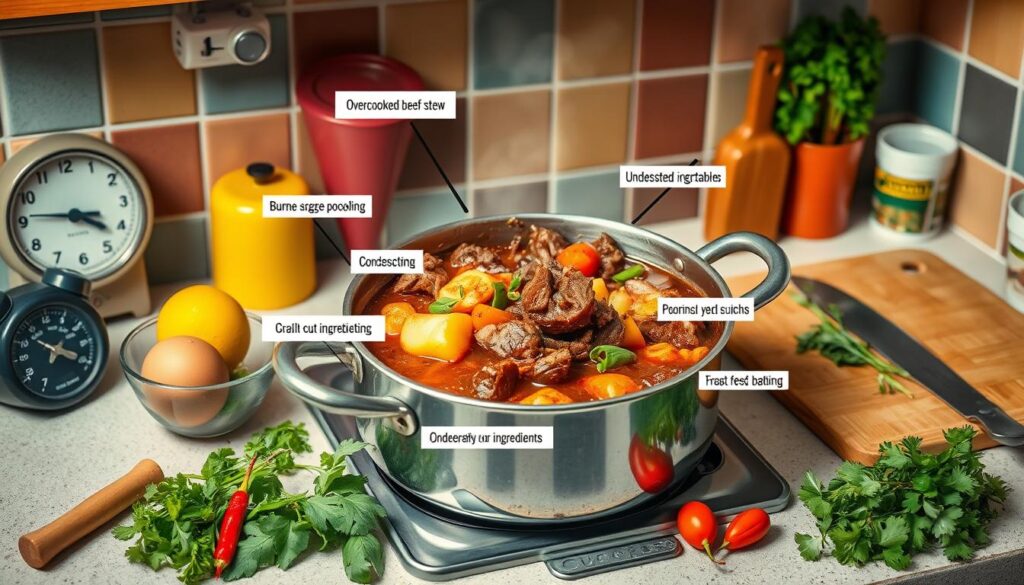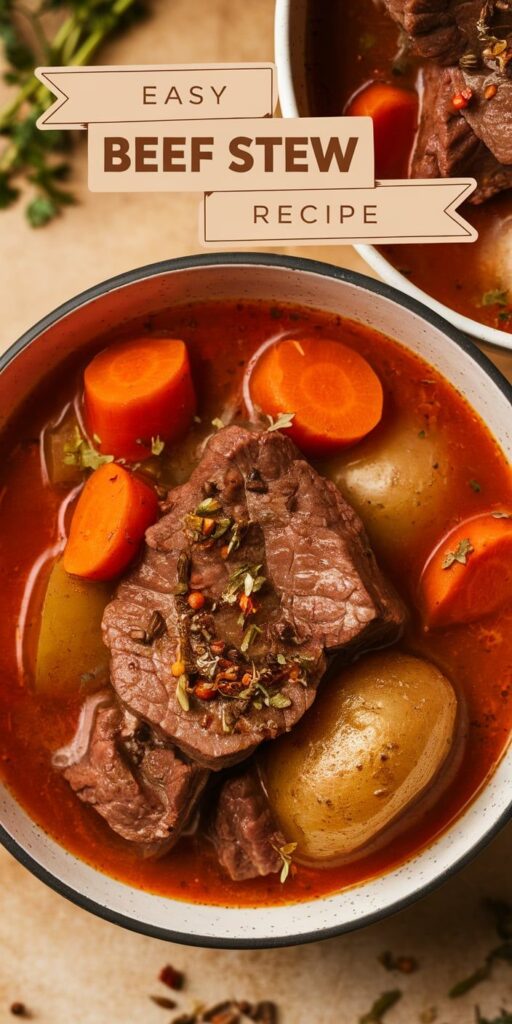Craving a hearty, comforting meal that will warm you up on a chilly day? Look no further than this easy beef stew recipe! This homemade beef stew is the perfect blend of tender chunks of beef, fresh vegetables, and savory seasonings, simmered to perfection for a dish that’s sure to become a family favorite.
Whether you’re in the mood for a cozy weeknight dinner or a satisfying weekend feast, this easy beef stew recipe is the answer. With its simple preparation and rich, flavorful results, it’s the ultimate comfort food that delivers on both taste and convenience. Get ready to enjoy a delicious, homemade beef stew that will have your taste buds singing!
What Makes This Beef Stew Recipe Special
This traditional beef stew recipe offers the best of both worlds – the rich, comforting flavors of a classic dish combined with modern time-saving techniques. By blending old-fashioned cooking methods with practical, family-friendly preparation, this recipe ensures a delicious and hassle-free meal every time.
Traditional Cooking Methods
To create the signature deep, savory notes of a traditional beef stew, this recipe calls for slowly simmering the ingredients to allow the flavors to meld together. The long cooking time helps to tenderize the beef, resulting in a melt-in-your-mouth texture that is the hallmark of a well-executed beef stew.
Modern Time-Saving Techniques
- One-pot cooking method for easy cleanup
- Use of a slow cooker or Instant Pot for hands-off preparation
- Streamlined ingredient list without sacrificing flavor
Perfect for Family Dinners
This beef stew recipe is an ideal choice for busy weeknight meals or cozy weekend gatherings. The hearty, comforting flavors and simple preparation make it a crowd-pleasing dish that the whole family will enjoy. Serve it alongside crusty bread or a fresh salad for a complete and satisfying dinner.
| Traditional Beef Stew | This Beef Stew Recipe |
|---|---|
| Lengthy cooking process | Time-saving techniques |
| Complex ingredient list | Streamlined ingredients |
| Requires close monitoring | One-pot or slow cooker method |
| May be intimidating for home cooks | Family-friendly and easy to prepare |
Essential Ingredients for the Perfect Beef Stew
Crafting the ultimate beef stew requires a carefully curated collection of ingredients that work in harmony to create a rich, flavorful dish. From the succulent beef to the aromatic seasonings, each component plays a vital role in achieving the perfect balance of taste and texture.
At the heart of this comforting stew is the beef itself. Look for high-quality beef chuck or stewing beef, which will become tender and melt-in-your-mouth after the long simmering process. Complementing the beef are an array of fresh vegetables, including carrots, potatoes, onions, and celery, each adding their own unique flavors and textures.
To bring it all together, a savory beef broth forms the foundation, infusing the stew with a deep, robust taste. Spices like bay leaves, thyme, and black pepper add depth, while a touch of tomato paste or Worcestershire sauce lends a subtle complexity.
| Beef Stew Ingredients | Quantity |
|---|---|
| Beef chuck or stewing beef | 2-3 lbs |
| Carrots | 4-6 medium |
| Potatoes | 6-8 medium |
| Onions | 2 large |
| Celery | 3-4 stalks |
| Beef broth | 4-6 cups |
| Tomato paste | 2 tablespoons |
| Bay leaves | 2-3 |
| Thyme | 1 teaspoon |
| Black pepper | 1 teaspoon |
With these essential ingredients on hand, you’re well on your way to creating a mouthwatering beef stew that will satisfy the whole family.
Choosing the Best Cuts of Beef for Stewing
When it comes to creating the perfect beef stew, the choice of beef is crucial. Two of the most popular and flavorful cuts for stewing are chuck roast and stewing beef. Let’s explore the key differences between these options and provide some valuable tips to ensure you select the best beef for your stew.
Chuck Roast vs. Stewing Beef
Chuck roast, a cut from the shoulder area, is often considered the go-to choice for beef stew. This cut is known for its rich, beefy flavor and excellent marbling, which helps the meat stay tender and juicy during the long cooking process. Stewing beef, on the other hand, is typically a combination of smaller, cubed pieces of beef, often from tougher, less tender cuts like the round or shank.
Meat Preparation Tips
Regardless of whether you choose chuck roast or stewing beef, it’s essential to properly prepare the meat before adding it to your stew. Start by cutting the beef into 1-inch cubes, ensuring consistent sizing for even cooking. Additionally, pat the meat dry with paper towels to help it sear and brown better in the pan.
Quality Indicators to Look For
- Look for best beef for stew that is deep red in color, with a firm, slightly marbled texture.
- Avoid beef that appears pale, dry, or excessively fatty, as these qualities can lead to a less flavorful and tender stew.
- When selecting chuck roast or stewing beef, choose cuts that are well-trimmed and free of excess gristle or connective tissue.
| Cut | Characteristics | Best Uses |
|---|---|---|
| Chuck Roast | Rich, beefy flavor, excellent marbling | Beef stew, pot roast, braising |
| Stewing Beef | Combination of smaller, cubed pieces from tougher cuts | Beef stew, slow-cooked dishes |
By understanding the differences between chuck roast and stewing beef, and following these tips for selecting and preparing the meat, you’ll be well on your way to creating a delicious and tender beef stew that your family will love.
Fresh Vegetables and Herbs You’ll Need
For a delectable beef stew, the right combination of fresh vegetables and aromatic herbs is essential. These ingredients not only add depth of flavor but also bring essential nutrients to the dish, creating a well-rounded and satisfying meal.
When it comes to stew vegetables, a variety of root vegetables are the foundation. Carrots, potatoes, and onions are classic choices that lend sweetness and texture to the stew. Additionally, inclusion of celery, stew vegetables, and fresh herbs for stew can elevate the dish with their complex flavors.
- Carrots
- Potatoes
- Onions
- Celery
- Root vegetables
Fresh herbs such as thyme, rosemary, and bay leaves are crucial for adding fragrance and nuanced taste to the stew. These fresh herbs for stew can be added whole or chopped, depending on personal preference and cooking method.
| Vegetable | Purpose | Quantity |
|---|---|---|
| Carrots | Sweetness and texture | 3-4 medium carrots, peeled and chopped |
| Potatoes | Starch and heartiness | 2-3 medium potatoes, peeled and cubed |
| Onions | Flavor base | 1 large onion, diced |
| Celery | Aroma and texture | 2-3 celery stalks, chopped |
By incorporating these fresh stew vegetables and aromatic fresh herbs for stew, you’ll create a beef stew that is both flavorful and nutritious.
Kitchen Tools and Equipment Required
Preparing the perfect beef stew requires more than just high-quality ingredients – having the right kitchen tools and equipment on hand is also essential. From the classic stew pot to helpful gadgets, let’s explore the essential cookware and accessories needed to bring your beef stew to life.
Essential Cookware
At the heart of any good beef stew is the vessel in which it’s cooked. The three go-to options are the stew pot, slow cooker, and Dutch oven. Each has its own unique advantages:
- A sturdy stew pot allows for stovetop simmering and easy monitoring of the cooking process.
- A slow cooker is perfect for hands-off cooking, gently tenderizing the meat over several hours.
- A Dutch oven can be used on the stovetop or in the oven, providing even heat distribution for rich, flavorful results.
Optional Helpful Gadgets
While not essential, a few additional tools can make your beef stew preparation even easier:
- A sharp chef’s knife for effortless chopping of vegetables
- A vegetable peeler for quickly preparing root vegetables
- A meat tenderizer to break down tougher cuts of beef
- A ladle for graceful serving of the stew
Storage Containers
After all the hard work of preparing your delicious beef stew, don’t forget about proper storage. Airtight containers, such as glass or BPA-free plastic, are ideal for keeping your stew fresh in the refrigerator or freezer. This way, you can enjoy the leftovers for days to come.
Easy Beef Stew Recipe Step-by-Step Instructions
Preparing a delectable beef stew is easier than you might think. Follow these simple step-by-step instructions to create a comforting and flavorful dish your whole family will enjoy.
- Start by gathering all the necessary ingredients, including beef, vegetables, broth, and seasonings.
- Season the beef with salt, pepper, and any other desired spices. Brown the beef in a large pot or Dutch oven over medium-high heat until it’s nicely seared on all sides.
- Add the chopped onions, carrots, and celery to the pot and sauté until they’re softened, about 5-7 minutes.
- Pour in the beef broth and scrape up any browned bits from the bottom of the pot. This will add tons of flavor to the stew.
- Toss in the potatoes, bay leaf, and any other vegetables you’re using, such as peas or mushrooms.
- Bring the stew to a boil, then reduce the heat to low, cover the pot, and let it simmer for 1-2 hours, or until the beef and vegetables are tender.
- During the last 30 minutes of cooking, you can thicken the stew by making a roux or adding a slurry of cornstarch and water.
- Taste the stew and adjust the seasoning with salt and pepper as needed.
- Serve the beef stew hot, garnished with fresh parsley or thyme, if desired. Enjoy!
By following these easy beef stew recipe steps, you’ll be able to create a comforting and flavorful how to make beef stew dish that’s perfect for a cozy family dinner. The cooking instructions are straightforward, and the result is a delicious, hearty meal that’s sure to satisfy.

Tips for Achieving the Perfect Consistency
Crafting a thick, velvety beef stew is an art form, and achieving the ideal consistency is crucial. Fortunately, with a few simple techniques, you can master the art of creating a stew that’s just right – not too thin, not too thick.
Thickening Methods
To thicken your beef stew, try these easy methods:
- Tossing the beef in flour before browning helps create a natural thickening agent.
- Mixing a cornstarch or arrowroot slurry into the stew towards the end of cooking will give it a silky-smooth texture.
- Mashing some of the cooked potatoes or vegetables against the side of the pot will release starch to thicken the liquid.
Liquid Ratios
Getting the right balance of liquid to solid ingredients is key for the perfect stew consistency. As a general guideline, aim for about 3 cups of liquid for every 2 pounds of beef and vegetables. Adjust the amounts as needed to achieve your desired thickness.
Cooking Time Adjustments
The longer you simmer a beef stew, the more the flavors will meld and the ingredients will break down, resulting in a thicker, richer consistency. If your stew is too thin, simply let it continue simmering for an additional 30 minutes to an hour. Conversely, if it’s too thick, add a bit more broth or water to thin it out.
| Thickening Method | Liquid Ratio | Cooking Time |
|---|---|---|
| Flour, cornstarch, or mashed veggies | 3 cups liquid per 2 lbs beef and veggies | Simmer for 30 mins to 1 hour |
By mastering these simple tips, you’ll be well on your way to creating a thick, beef stew that’s sure to satisfy. Experiment with different techniques to find the perfect consistency that your family will love.
Common Mistakes to Avoid When Making Beef Stew
Preparing a delectable beef stew can be a culinary delight, but even experienced home cooks can fall victim to common pitfalls. By being mindful of these beef stew mistakes and cooking errors, you can ensure a successful and flavorful outcome every time.
One of the most frequent troubleshooting issues is overcooking the beef, leading to a tough and chewy texture. To avoid this, be sure to use the right cut of meat, such as chuck roast or stewing beef, and adjust the cooking time accordingly. Additionally, resist the urge to stir the stew constantly, as this can break down the meat and result in a mushy consistency.
Another common mistake is skimping on the vegetables or using subpar produce. Fresh, high-quality ingredients are essential for a well-balanced and hearty stew. Be sure to include a variety of root vegetables, such as carrots, potatoes, and onions, as well as aromatic herbs and spices to enhance the overall flavor profile.
Lastly, failing to properly thicken the stew can result in a thin, watery consistency. Experiment with different thickening methods, such as adding a roux or using a cornstarch slurry, to achieve the desired creamy texture.

By avoiding these beef stew mistakes and addressing any cooking errors along the way, you can ensure that your homemade beef stew is a resounding success, perfect for sharing with family and friends.
Storage and Reheating Guidelines
Proper storage and reheating techniques are essential for preserving the delicious flavor and texture of your homemade beef stew. By following a few simple guidelines, you can enjoy your leftover stew for days to come.
Storing Beef Stew
To store your beef stew, allow it to cool completely before transferring it to an airtight container. Glass or BPA-free plastic containers work best, as they won’t absorb any odors or flavors. Stew can be refrigerated for up to 4 days or frozen for up to 3 months.
Reheating Stew
When you’re ready to enjoy your leftover beef stew, there are a few options for reheating it. The stovetop is the most convenient method – simply transfer the stew to a saucepan and heat it over medium, stirring occasionally until warmed through. Alternatively, you can reheat it in the microwave, checking and stirring the stew every 30 seconds to ensure even heating.
No matter which reheating method you choose, be sure to heat the stew thoroughly to an internal temperature of 165°F (74°C) to kill any harmful bacteria. Stir the stew occasionally and taste it before serving to ensure it’s piping hot and ready to enjoy.
Freezing Leftover Stew
For longer-term storage, beef stew freezes remarkably well. Once cooled, transfer the stew to airtight, freezer-safe containers or bags, leaving a bit of headspace to allow for expansion. Properly stored, frozen beef stew can last for up to 3 months in the freezer.
When reheating frozen stew, you can thaw it in the refrigerator overnight or reheat it directly from frozen, adding a bit of extra time to ensure it’s heated through. With these simple storage and reheating tips, you can savor the delicious flavors of your homemade beef stew for days or even weeks to come.
Serving Suggestions and Side Dish Pairings
Once your delectable beef stew is ready, it’s time to elevate the dining experience. Serve the stew in warm, rustic bowls to capture the comforting essence of this dish. Pair it with crusty bread or soft, flaky biscuits for sopping up every last drop of the rich, flavorful broth.
For a heartier meal, consider serving the beef stew over a bed of creamy mashed potatoes or fluffy white rice. The smooth, starchy base will complement the tender beef and vegetables perfectly. Steamed or roasted vegetables, such as carrots, green beans, or Brussels sprouts, make excellent sides that will round out the dish.
To add a refreshing contrast, a simple green salad with a tangy vinaigrette dressing can provide a nice balance to the stew. For those seeking a little extra indulgence, a crusty loaf of garlic bread or a side of buttery cornbread are delightful pairings that will elevate the overall dining experience.





